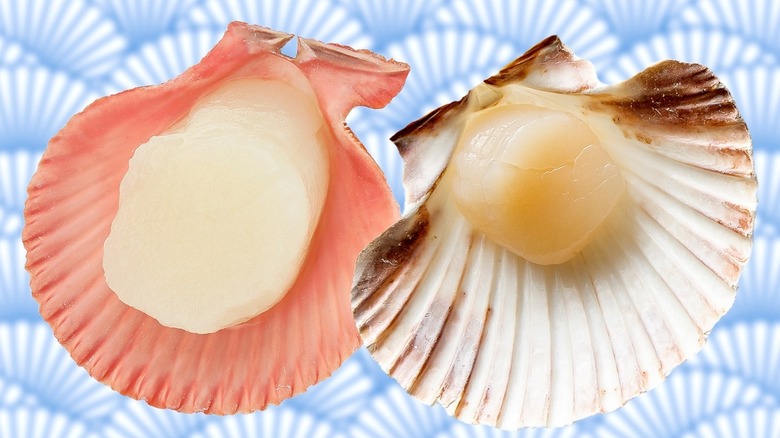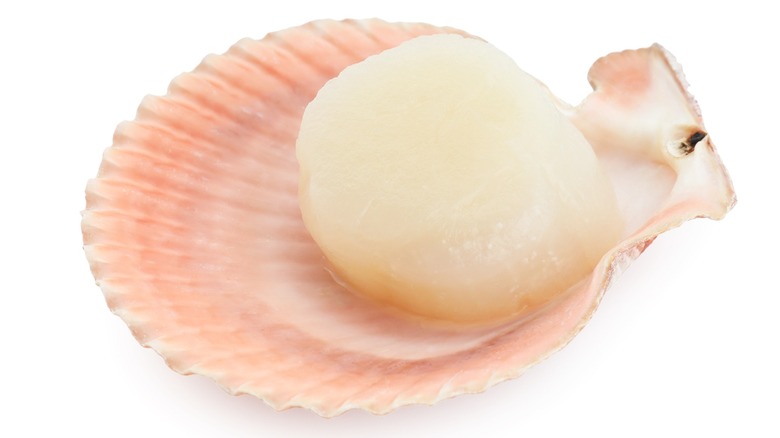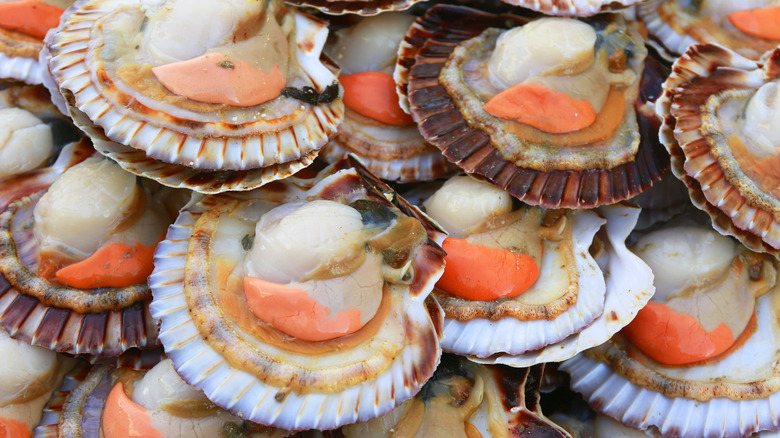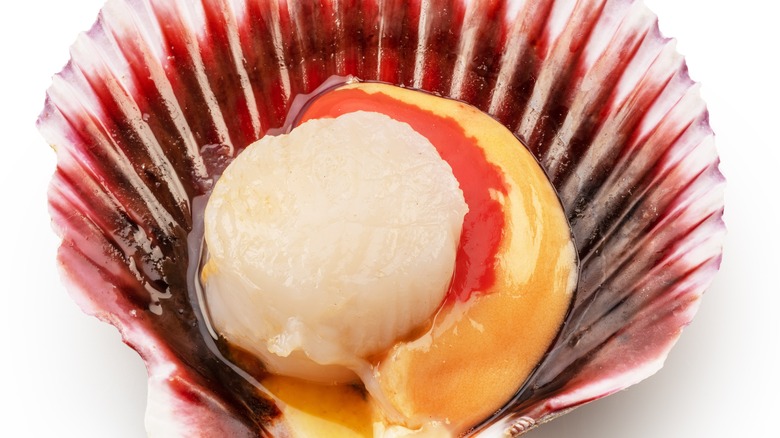What's The Difference Between Pink And White Scallops?
Scallops are the sea's buttery gift to us landlocked folks. They're so unique with their briny flavor and smooth, meaty texture. When we buy scallops at the market, they're typically removed from the shell to reveal the meaty adductor muscle, which is what we actually consume. This strong muscle is what the mollusk uses to open and close its fan-shaped shell, and it's mighty delicious.
Scallops, along with clams, oysters, and mussels, are in the bivalve mollusk family. With 18 different species being commercially harvested, it can be hard to distinguish between each type of scallop, and that's not even factoring in the 400 total species spanning the globe. There are the big heavier ones known as sea scallops, and then bay scallops, their smaller sibling. Aside from size difference, there's another thing to look out for when plotting your scallop dinner: color.
If you were to look at a plate of entirely female scallop meat, you might not note the bold blush color, but when placed right beside a soft white scallop, the contrast is stark. When picking out the best looking scallops to bring home for dinner, you might spot one or two pink outliers hiding behind all of the ordinary white scallops. The main difference is that the familiar white scallops are male, whereas the warmer, coral-colored scallops are spawning females. In other words, their color comes from the bright orange eggs they produce.
What are white scallops?
When we think of decadent scallops seared with butter, chances are we're daydreaming of male mollusks, which are characteristically ivory-white with an almost creamy appearance. Male scallops aren't necessarily more common in nature, but markets typically aim for uniformity, and one pink scallop amongst a sea of white will stick out like a sore thumb. Home chefs new to scallops will often question if the lone orangey one is spoiled, but thankfully, it's just as delicious, and extra special.
While all seafood shares a certain earthy brininess, scallops are a special breed. There's something light and clean about the flavor, but with an incredibly rich texture that's unlike anything else. The taste is so powerful that scallops are renowned for needing nothing more than a quick sear, and this goes for scallops of any shade. If not that opaque color, scallops are a bright orange that's impossible to miss. Technically speaking, these are the same as the paler, beige scallops we commonly find at the grocery store.
What are pink scallops?
While the same shape and size as typical white scallops of the same region, the pink ones aren't hard to distinguish given their vibrant hue. Though contrasting colors, the muscles themselves function the same way. What alters the color (and flavor, according to some) is what sits in the shell with the muscle, which in this case is roe, gonads, or, in short, the scallop's egg sac. Much like other eggs from the sea, scallop roe is an intense orange color, and when the glands fill with roe, the muscle takes on some of that potent coloring. Considering that most American seafood markets and grocery stores sell scallops sans shell, the bright roe is long gone once it reaches our kitchens — but the muscle's color is forever.
The taste is equally as intoxicating as white scallops; buttery, salty, and sweet. Many say that the brighter tinted scallops taste the same, while others swear up and down that roe-infused scallop meat is better. America's Test Kitchen concluded that the female scallops "had a noticeably sweeter, richer flavor," whereas Martha Stewart believes there's no difference between the two once cooked. The quality of the scallop will play a huge role, especially if eaten raw or prepared as a fresh ceviche, but female scallops do seem to have a special edge to them.
Elusive pink scallops are harder to come by
It's harder to find the bright pinkish female scallops, as they're not typically sold separately from their male counterparts. Luckily, their color gives them away, so you just have to pay close attention to what is being tossed on the scale at your local fish market. Get on your fishmonger's good side and ask them to poke around for the orangey female scallops. If you're intrigued by the delicacy, they might even throw in the roe that gives the scallops their signature color.
In North America, the roe is typically tossed after shucking, which would make gourmands in France livid. Scallop roe has remained a delicacy in France for ages, which largely has to do with the natural sweetness it garners from the North and Irish Seas. When the curious seek out scallop roe in the U.S., it's likely imported from Europe anyhow. As succulent as North American scallops are, the roe doesn't fare as well. It's reportedly "grainy," according to The New York Times. While eating the roe itself is an acquired taste, the female scallop muscle doesn't take on the same unique texture and intense aroma, only subtle flavor nuances and color.



